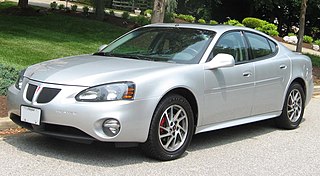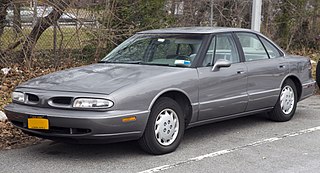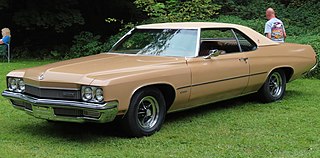
Oldsmobile or formally the Oldsmobile Division of General Motors was a brand of American automobiles, produced for most of its existence by General Motors. Originally established as "Olds Motor Vehicle Company" by Ransom E. Olds in 1897, it produced over 35 million vehicles, including at least 14 million built at its Lansing, Michigan factory alone. During its time as a division of General Motors, Oldsmobile slotted into the middle of GM's five divisions, and was noted for several groundbreaking technologies and designs.

The Buick Skylark is a passenger car formerly produced by Buick. The model was made in six production runs, during 46 years, over which the car's design varied dramatically due to changing technology, tastes, and new standards implemented over the years. It was named for the species of bird called skylark.

The Chevrolet Bel Air is a full-size car produced by Chevrolet for the 1950–1975 model years. Initially, only the two-door hardtops in the Chevrolet model range were designated with the Bel Air name from 1950 to 1952. With the 1953 model year, the Bel Air name was changed from a designation for a unique body shape to a premium level of trim applied across a number of body styles. The Bel Air continued with various other trim level designations, and it had gone from a mid-level trim car to a budget fleet sedan when U.S. production ceased in 1975. Production continued in Canada, for its home market only, through the 1981 model year.

The Oldsmobile Cutlass was a series of automobiles produced by General Motors' Oldsmobile division between 1961 and 1999. At its introduction, the Cutlass was Oldsmobile's entry-level model; it began as a unibody compact car, but saw its greatest success as a body-on-frame intermediate. The Cutlass was named after the type of sword, which was common during the Age of Sail.

The Buick Electra is a full-size luxury car manufactured and marketed by Buick from 1959 to 1990, over six generations. Introduced as the replacement for the Roadmaster lines, the Electra served as the flagship Buick sedan line through its entire production and was offered as a six-passenger four-door sedan with two-door sedan, two-door convertible, and five-door station wagon variants.

The Grand Prix is a line of automobiles produced by the Pontiac Division of General Motors from 1962 until 2002 for coupes and 1989–2008 for sedans.

The Oldsmobile 98 is the full-size flagship model of Oldsmobile that was produced from 1940 until 1942, and then from 1946 to 1996. The name – reflecting a "Series 90" fitted with an 8-cylinder engine – first appeared in 1941 and was used again after American consumer automobile production resumed post-World War II. It was, as it would remain, the division's top-of-the-line model, with lesser Oldsmobiles having lower numbers such as the A-body 66 and 68, and the B-body 76 and 78. The Series 60 was retired in 1949, the same year the Oldsmobile 78 was replaced by the 88. The Oldsmobile 76 was retired after 1950. This left the two remaining number-names to carry on into the 1990s as the bread and butter of the full-size Oldsmobile lineup until the Eighty Eight-based Regency replaced the 98 in 1997.

The Oldsmobile 88 is a full-size car that was sold and produced by Oldsmobile from 1949 until 1999. From 1950 until 1974, the 88 was the division's most profitable line, particularly the entry level models such as the 88 and Dynamic 88. The 88 series was also an image leader for Oldsmobile, particularly in the early years (1949–51), when it was one of the best performing automobiles, thanks to its relatively small size, light weight, and advanced overhead-valve high-compression V8 engine. This engine, originally designed for the larger C-bodied and more luxurious 98 series, also replaced the straight-8 on the smaller B-bodied 78. With the large, high performance V8, the Oldsmobile 88 is considered by some to be the first muscle car, although this title is disputed.

The Pontiac Catalina is a full-size, junior series automobile produced by Pontiac from 1950 to 1981. Initially, the name was a trim line on hardtop body styles, first appearing in the 1950 Chieftain Eight and DeLuxe Eight lines. In 1959, it became a separate model as the "entry-level" full-size Pontiac.

The Pontiac Bonneville is an automobile built by Pontiac from 1957 until 2005. Bonnevilles were full-sized, with the exception of a brief period of mid-size between 1982 and 1986. The brand was introduced as a limited production performance convertible during the 1957 model year. The Bonneville, and its platform partner, the Grand Ville, are some of the largest Pontiacs ever built; in station wagon body styles they reached just over 230 inches (5.8 m) long, and at 5,000 pounds (2,300 kg) and more were also some of the heaviest cars produced at the time.

The Pontiac Tempest is an automobile that was produced by Pontiac from 1960 to 1970, and again from 1987 to 1991.

The Oldsmobile Cutlass Supreme is a mid-size car produced by Oldsmobile between 1966 and 1997. It was positioned as a premium offering at the top of the Cutlass range. It began as a trim package, developed its own roofline, and rose during the mid-1970s to become not only the most popular Oldsmobile but the highest selling model in its class.

The Oldsmobile Starfire is an automobile nameplate used by Oldsmobile, produced in three non-contiguous generations beginning in 1954. The Starfire nameplate made its debut as a convertible concept car in 1953 followed with the 1954–1956 Ninety-Eight series convertibles that shared a "halo status" with the Buick Skylark and Cadillac Eldorado. For 1957 only, all Ninety-Eight series models were named "98 Starfire ".

The Oldsmobile 4-4-2 is a muscle car produced by Oldsmobile between the 1964 and 1987 model years. Introduced as an option package for US-sold F-85 and Cutlass models, it became a model in its own right from 1968 to 1971, spawned the Hurst/Olds in 1968, then reverted to an option through the mid-1970s. The name was revived in the 1980s on the rear-wheel drive Cutlass Supreme and early 1990s as an option package for the new front-wheel drive Cutlass Calais.

The Pontiac LeMans is a model name that was applied to subcompact- and intermediate-sized automobiles marketed by Pontiac from 1961 to 1981 and 1988-1993 model years. Originally a trim upgrade based on the Tempest, it became a separate model. In 1964 the Tempest was available with an optional GTO package that later became a separate model, the Pontiac GTO, muscle car. 1970 introduced the GT-37 package.

The Buick Centurion is a full-size car built from the 1971 through 1973 model years. Replacing the Wildcat as the sporty iteration of Buick's three full-size car lines, it was positioned between the LeSabre and Electra in the lineup. The Centurion name was inspired by a Buick concept car, the name coming from that of an officer in the Roman Army. The car's emblem was not the traditional Buick tri-shield, but a side profile of a centurion.

The Buick LeSabre is a full-size car made by the division Buick of General Motors from 1959 until 2005. Prior to 1959, this position had been retained by the full-size Buick Special model (1936–58). The "LeSabre", which is French for "the sabre", was Buick's mid-level full-size sedan above the Special but below the Electra during the 1960s then remained in its market position when the Electra was replaced with the Park Avenue. The LeSabre was available as a 2-door convertible, sedan or hardtop, a 4-door sedan or hardtop and station wagon throughout its production.

The Pontiac Ventura was an automobile model that was produced by Pontiac. As was common practice at the time, its name was derived from Ventura, California, joining other similarly derived models such as the fellow Pontiac Catalina, the Chevrolet Malibu, and the rival Mercury Monterey.

The fifth generation of the Chevrolet Impala is a line of full-size cars produced by Chevrolet from the 1971 to 1976 model years. The largest generation of the model line, the fifth-generation Impala grew to a 121.5-inch wheelbase

The Chevrolet Impala (fourth generation) are full-size automobiles produced by Chevrolet for the 1965 through 1970 model years. The 1965 Impala was all new, while the 1967 and 1969 models featured new bodies on the same redesigned perimeter frame introduced on the 1965 models. All Impalas of this generation received annual facelifts as well, distinguishing each model year. Throughout the early 1960s, Chevrolet's basic body designs became increasingly subtle, while the bright trim that was part of the Impala package added more than a touch of luxury to the look. The same pattern was followed in the interiors, where the best materials and equipment Chevrolet had to offer were displayed. In short, the Impala was on its way to becoming a kind of junior-grade Cadillac, which, for both the company and its customers, was just fine.






















